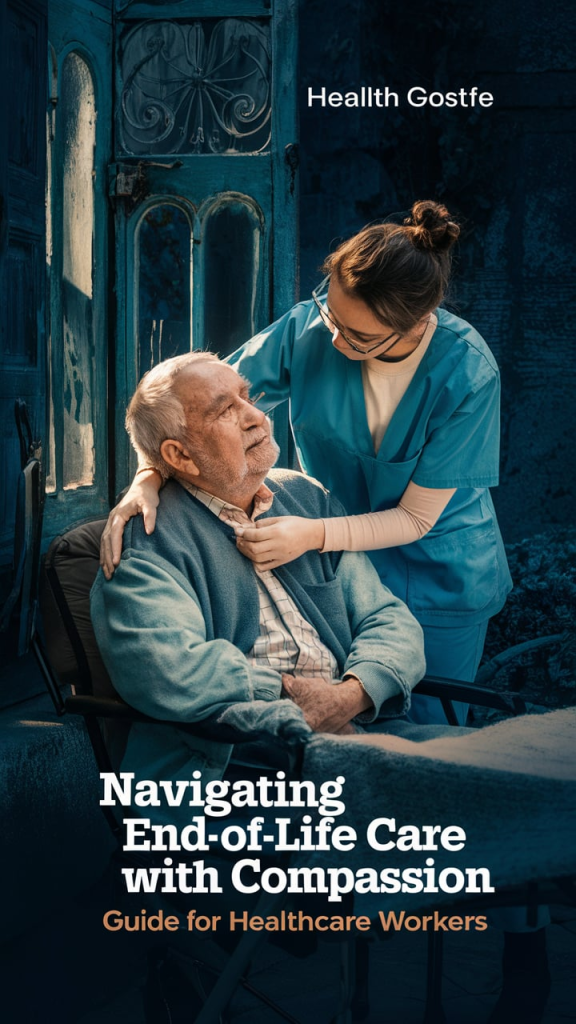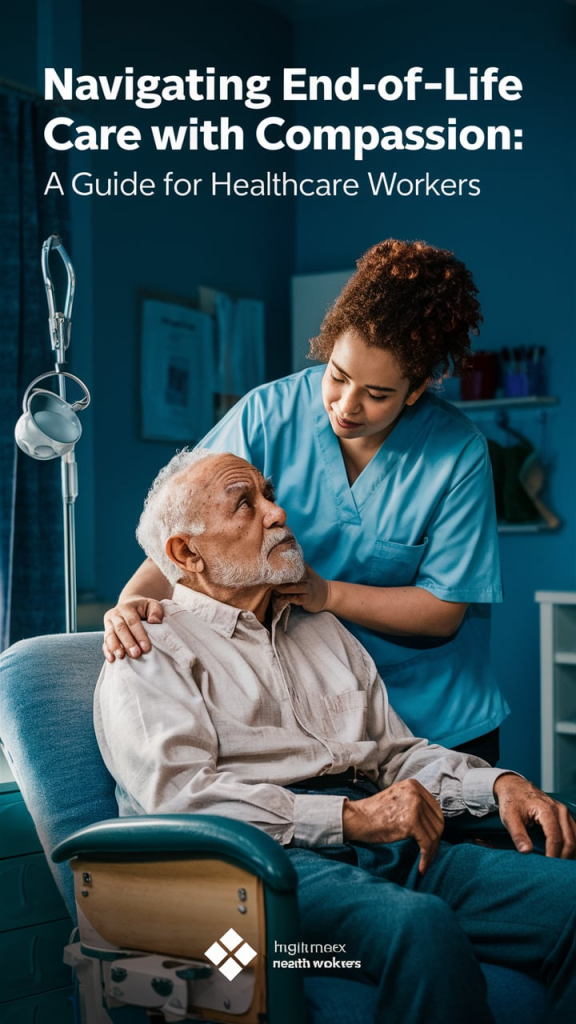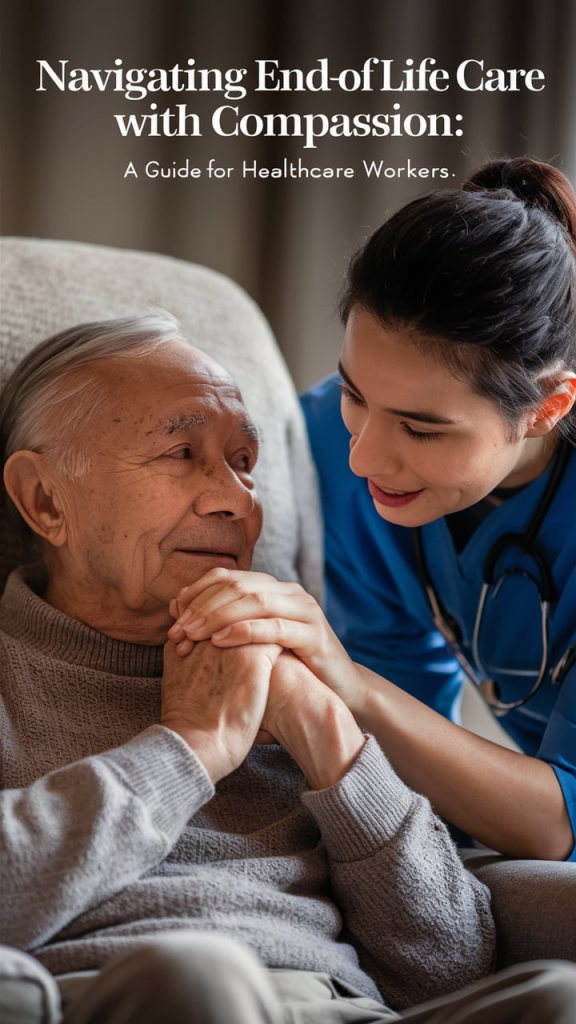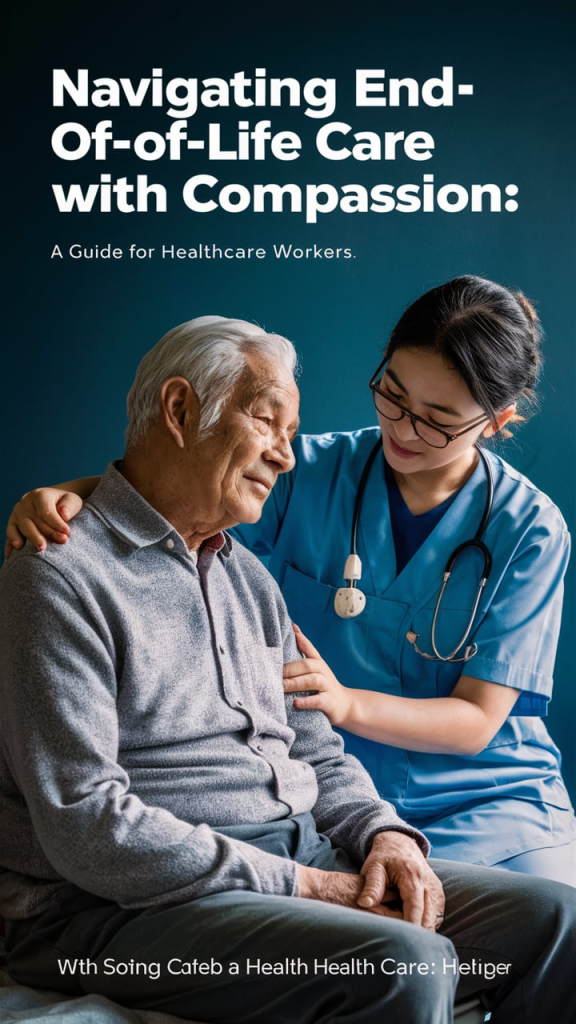Navigating End-of-Life Care with Compassion: A Guide for Healthcare Workers
Undoubtedly, healthcare workers are heroes who don’t wear capes. They are at the forefront, providing care and support to patients, no matter their underlying health condition with some being at their most vulnerable moment in life. When a patient starts to deteriorate rapidly towards the end of life, a certain level of a delicate, realistic blend of medical and compassionate care is applied with a touch of empathy and not sympathy. In this post, we will delicately explore the right way for healthcare workers to act during this stage in their occupation, navigating through emotional challenges, to ensure that every patient receives the dignity, comfort and care they deserve.
Always ensure you read the care plan of any service user before you attend to them. This helps you avoid issues that go against the care plan, it helps you stay professional, and it helps you stay away from healthcare issues.

1. Open Communication with end-of-life patient
Establishing open and honest communication with a patient is significant to them because some might not have a family opportunity to be there for them like you are, so you play the family and friend role. If possible, freely listen and contribute when the patient wants to talk about their transition to the end of life. Encourage and don’t cut short the expression from the patient when they start talking. Listen to their goals and concerns, in addition to whatever they are interested in talking about.

2. Compassionate and Empathetic with end-of-life patient
The need for healthcare workers to be empathetic can never be overemphasized. People who are in it for the money never get away with hiding it, because it shows. It is never hard to be empathetic to a person going through a hard time in life. Being a compassionate and empathetic worker can provide some good comfort to the patient and their families. Try being patient, listen actively, and acknowledge their pains/concerns and all the emotional toll that their underlying health condition brings. Don’t always be in a haste to leave them alone.
3. Inclusive Family Discussions
You always mentally know the line that exists within the job as it concerns the confidentiality of the client or service users and the carer. But when you are allowed to get involved in the end of life conversations, involving the patient’s family is appropriate. From telling them what their loved one has said that may be worthy of noting, help them understand the stages and consequences of the health condition that their loved one is suffering from, its prognosis, the options that are left for the loved one, helping families understand enough to ask questions and clarify their doubt.
4. Encourage the Client’s decision-making abilities
Carers are expected to respect a patient’s autonomy in decision-making. If a patient is capable, please involve them in decisions that concern them, especially when it comes to their treatments and day-to-day preferences. prioritising their wishes and choices will make them feel heard, bringing them some measure of comfort and appreciation.

5. Pain and Symptom Management
Prioritise the effective pain and symptoms of the service users. Collaborating with the palliative care team to ensure the service user is as comfortable as possible, with regular assessment to identify and address symptoms in line with the care plan.
6. Prepare and Update Advance Care
Carers and families should discuss advanced care planning early enough when the service user can still speak and make sane decisions, with their wishes documented and respected, which will be updated as time goes on.
7. Ensure a Smooth Care Coordination
The most appropriate thing to do for your service user will be to enable seamless coordination of the various healthcare providers, this will help ensure that everyone is on the same page regarding the service user and their needs.

8. Cultural and Religious Sensitivity
Carers should endeavour to recognise a service user’s culture, family tradition, and religion, as this will enable them to align with the service user’s end-of-life tradition or religious practices, especially if they would love for their religious leader to visit them and have a final word of prayer with them.
9. Educate the patient and family
Be as clear as possible with the patient and their family, when it comes to the medical update, let them know what to expect in the coming days from the medical practitioner and what that means for the patient and their family. When more clarity is required by a family member, always direct them to do more reading, especially on how to best support the patient, while navigating the difficult phase of their life. In most cases, the family members are first updated about the medical development of their family members, and when this happens, they will become the ones to update on their health condition, and in that case, they become the ones to tell the health care company what update has been given.
10. Provide Anticipatory Guidance
To the best of your knowledge and expertise, you have to offer anticipatory guidance to prepare patients and their families for changes that might not have a pleasant outcome. For example, when the way a service user eats has to change from solid to puree because they have become prone to choking, it might become a little overwhelming for the family to accept that things may have deteriorated for their family member.
11. Respectfully Continue your end-of-life duty until the last breath
When you have a duty of care to an end-of-life patient, ensure you continue to it to the last breath, because a patient might look like they are as good as gone, yet they breathe. XCarers are always confused at this stage, wondering if it is worth their care. The service user is worth your duty of care, and continue the chosen end-of-life ritual or cultural practice that has been picked by the service user or a family member whose opinion they value. Continue to speak to them in their fragile state as study shows that they can still hear you, and might be able to respond. protect their dignity and make sure they do not look or smell horrible on their dying bed because this is something no one would want. If you picture them as a family member you hold dearly, you would do right by them. So going by your work ethic, religious requirement and conscience, you should do all in your power to make their helpless appearance as okay as possible.
12. Post- Mortem Support
Some care companies provide post-mortem services to their clients while others don’t. If your company does them that means you will need to maintain contact with the service user. But if your company doesn’t, you are expected to cut all communication and ties with the bereaved family, then do well to stay away from the family professionally. Do not pay visits or send flowers/gifts, unless you are related or a neighbour to the family, as your presence might remind the family of their loved one who just passed because they would have associated your presence with that of the service user. Carers are advised not to be emotional.
Understanding End-of-Life Care: Drugs, Signs, Medications, and More
Though the name may imply the meaning, End-of-life care is a crucial phase in healthcare, with an aim to provide comfort and support to individuals in the final stages of life, due to health condition that has been confirmed by a medical practioner. This section explores the questions surrounding the end-of-life care, from drugs, signs, medications, issues, and common questions related to the process.
What are End-of-Life Drugs?
End-of-life or palliative drugs, also known as palliative medications, are used to manage symptoms and alleviate discomfort in patients nearing the end of their lives. These drugs aim to improve the quality of life rather than cure the illness. Common end-of-life drugs include pain relievers like morphine, anti-anxiety medications such as lorazepam, anti-nausea drugs like ondansetron, and antipsychotic medications such as haloperidol to manage delirium or agitation. The aim is to make the patient as comfortable as possible.

What are End-of-Life Signs?
End-of-life signs indicate that a person is approaching the final stage of life. These signs can vary, based on the individual, their environmental condition, but often include:
- Increased fatigue and sleepiness
- Reduced appetite and fluid intake
- Changes in breathing patterns, such as Cheyne-Stokes respiration
- Decreased body temperature and blood pressure
- Mottling of the skin, particularly on the hands and feet
- Withdrawal from social interactions
- Confusion or disorientation
What are End-of-Life Medications?
End-of-life medications are specifically prescribed to manage symptoms and ensure comfort during the final days or weeks of life. These medications address pain, anxiety, nausea, respiratory secretions, and other distressing symptoms. Commonly used medications include opioids for pain relief, benzodiazepines for anxiety, anticholinergics to reduce secretions, and antiemetics for nausea control.
What are End-of-Life Issues?
End-of-life issues encompass a range of physical, emotional, spiritual, and ethical concerns that arise during the final stage of life. These issues include:
- Pain and symptom management
- Decision-making regarding treatment preferences
- Emotional support for the patient and their family
- Spiritual care and addressing existential concerns
- Legal matters, such as advance directives and wills
- Ethical dilemmas, including decisions about life-sustaining treatments

Can End-of-Life be Reversed?
End-of-life, by definition, refers to the final stage of a terminal illness where death is imminent and cannot be reversed. However, in some cases, a patient’s condition may stabilize or improve temporarily, leading to what is known as a “rally.” While these moments of improvement can bring hope, they do not typically indicate a reversal of the overall trajectory towards death.
Can End-of-Life Patients Eat?
End-of-life patients may have a decreased appetite and reduced ability to eat or drink. As the body naturally begins to shut down, the need for food and fluids diminishes. While some patients may still be able to consume small amounts of food and drink, it is essential to focus on comfort and allow the patient to eat or drink as desired without forcing intake.

Can End-of-Life Last Months?
End-of-life can last for months, depending on the individual’s condition and the nature of their illness. The progression towards the end of life can vary significantly, with some patients experiencing a gradual decline over weeks or months, while others may decline more rapidly.
Can End-of-Life Care Be Done at Home?
End-of-life care can be provided at home, allowing patients to remain in a familiar and comfortable environment. Home-based end-of-life care often involves a team of healthcare professionals, including hospice nurses, palliative care specialists, and home health aides, who work together to manage symptoms and support the patient and their family.
Can End-of-Life Patients Hear You?
It is commonly believed that hearing is one of the last senses to fade as a person nears death. End-of-life patients may still be able to hear even when they cannot respond. Speaking to the patient in a calm, reassuring manner and offering words of comfort can be meaningful and provide solace during their final moments.

Can End-of-Life Diagnosis Be Wrong?
While healthcare professionals use their expertise to assess and diagnose end-of-life, prognoses can be inaccurate. Predicting the exact timeline of death is challenging, and patients may live longer or shorter than expected. Regular reassessment and open communication with the healthcare team are crucial for addressing any changes in the patient’s condition.
Understanding the various aspects of end-of-life care can help individuals and their families navigate this challenging time with greater clarity and compassion. By addressing these questions, we hope to provide valuable insights and support for those facing end-of-life decisions.
Conclusion
Unknown to most care workers and companies, when playing the role of a healthcare worker who is navigating the end of life for a service user, you are supporting the patient and their families at the same time. The care entails a medical and compassionate blend of feelings, in addition to open communication, inclusive family discussion, encouraging decision-making abilities and more, to contribute to compassionate and meaningful end-of-life, helping them achieve the medical, emotional and religious support they want for their end of life, to enable them peacefully transition.
